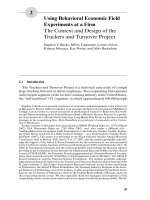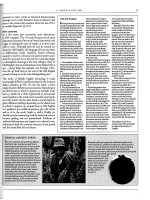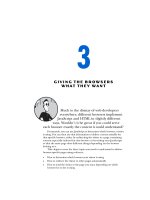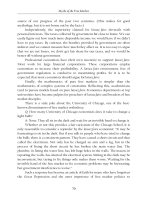age of inflation continued exposes criminal monetary policies of us federal reserve phần 2 pps
Bạn đang xem bản rút gọn của tài liệu. Xem và tải ngay bản đầy đủ của tài liệu tại đây (52.62 KB, 10 trang )
The Dollar Standard
We may not be able to see the future, but we can always learn
from the past. A cursory look at the history of international
monetary systems may reveal where we were, where we are, and
where we are heading. Ever since the dawn of civilization,
precious metals have had wide monetary use, due to their
convenience of handling, durability, divisibility, and their high
value as jewelry. During the Middle Ages, European countries
strove toward bimetallism, that is, the use of gold and silver as the
monetary standard of value. The United States government
adopted a bimetallic standard at its very beginning and clung to it
throughout most of the 19
th
century. England was the first country
that made gold the standard currency in 1798 and 1816; many
countries hesitantly followed suit, the United States in 1900.
Under this system, gold became the standard of value throughout
the commercial world, furnishing a price denominator for all
goods and services. Gold coins passed freely from hand to hand
in full payment for economic goods and in discharge of
indebtedness. They had no regional or national limitation, being
accepted and traded all over the globe.
The age of the classical gold standard was rather short; it came
to an abrupt end in 1914 when World War I erupted in Europe.
The belligerent governments immediately revoked their
8
The Dollar Standard
redemption obligations, enabling them to issue money freely and
generously. After the war, while the vanquished countries
continued to inflate their currencies at accelerating rates until they
became practically worthless, the victors soon replaced the coin
standard with a bullion standard which used gold in the form of
bars and ingots in international payment. The Great Depression
soon smothered this system with massive budget deficits and
numerous regulations and controls.
At the Bretton Woods international conference in 1944, the
representatives of allied nations tried to restore monetary order by
creating yet another system, the gold-exchange standard. The
member countries fixed the value of their currencies not to gold,
but to some foreign exchange, which in turn was redeemable in
gold at a given ratio. Most governments fixed their currencies to
the U.S. dollar and retained dollar reserves in the United States.
In fact, they created an incipient dollar standard resting on gold.
It served satisfactorily during the 1950s, facilitating numerous
readjustments to the dollar, but came under severe pressure during
the 1960s when President Johnson introduced his Great Society
and waged war in Vietnam. Massive budget deficits, which the
Federal Reserve readily facilitated, soon weakened international
confidence in the integrity of the dollar, which led some dollar-
holding countries to seek exchange of their dollars for gold. With
the specter of U.S. international insolvency coming in sight, and
in order to avoid the unthinkable, the U.S. government, in 1968,
introduced a two-tier system, which limited payment of gold to
foreign central banks at $35 an ounce, but denied gold payment to
all others. And in support of the waning U.S. gold reserves, the
International Monetary Fund created Special Drawing Rights as a
new currency reserve. Despite all such measures, the drain on
U.S. gold reserves continued.
The year 1971 was to be a landmark in monetary history. On
August 15, the United States government removed gold as the
foundation stone of the international monetary order and
9
Age of Inflation Continued
rescinded the international agreements that had defined the
system since the end of World War II. In a nationally televised
address, President Nixon simply announced that the United States
would no longer honor its 26-year-old commitment to pay
international obligations in gold at the rate of $35 an ounce. He
imposed a 10 percent surcharge on imports into the United States
and, above all, ordered virtually all wages and prices to freeze.
Violators would be fined, imprisoned, or both. When the controls
created frustrating problems, they underwent four "phases" of
adjustment to "problem areas" such as food, health care, and
construction.
The new fiat-dollar standard was a germane derivative of the
Bretton Woods order, without its limitations. Liberated at last
from any gold reserve requirement, it promised to serve all
political needs. Unfortunately, it proved to be even less stable
than its harbinger, more inflationary and, above all, more divisive
and injurious to American prosperity and prestige.
Withdrawal of American troops from Vietnam in 1972 and
1973 did not end the price and wage spirals that were to mark the
presidencies of Messrs Nixon, Ford, and Carter. With the federal
government incurring massive budget deficits, the Federal Reserve
duly supplied funds at single-digit interest rates, bank credit
expanded at double-digit rates, and goods prices soared. The Fed
occasionally would "tighten" its reins, but its rates always
remained below market rates, often even below the rates of
inflation. U.S. trade deficits increased erratically with dollar funds
flowing to Western Europe and Japan, but the monetary authorities
in Europe and Japan liked the exchange rates and defended them
with substantial purchases of dollars. Their dollar support meant
to sustain their own exports and to bolster and subsidize their own
export industries. The abundance of dollar funds in central banks
throughout the world then facilitated an explosive growth of
money and credit in most industrial countries.
In 1974 and 1975, the fever of double-digit inflation was
10
The Dollar Standard
briefly eclipsed by the chills of recession. American
unemployment rose to 8.3 percent, a 33-year-high nationally, and
much higher in construction and manufacturing. It remained high
although the chills of recession soon gave way again to the fever
of inflation. Money and credit were made to expand again at
double-digit rates, trade deficits set new records, and the U.S.
dollar deteriorated further in international markets. By the end of
the decade, the country fell again into the grip of the twin
economic evils of recession and inflation. Unemployment rose
again while GNP was falling. The Federal Reserve, under new
management, finally meant to call a halt to the foment. It raised
its discount rate to 12 percent, the prime rate rose above 15
percent, and the eurodollar rate to 20 percent. President Carter
joined the campaign by imposing federal temperature controls in
public and commercial buildings, setting minimum summer
temperature at 78 degrees and maximum winter temperature at 65
degrees. Many Americans keenly felt the effects of gasoline
rationing, waiting in long lines at gasoline service stations.
Legislators and regulators had a ready explanation for the crisis:
the sheikhs and emirs of OPEC had done it again.
In 1981, President Reagan took the helm of a deeply troubled
country. During his eight years in office he managed to lift the
spirits, changing the course, and relaxing the reins of government.
He rolled back the Johnson Great Society but preserved the
Roosevelt New Deal. He rejected Keynesian formulas for
managing economic demand and instead followed "supply-side"
prescriptions which aim to stimulate production and investment by
way of tax reduction and removal of some government controls.
Mostly at loggerheads with Congress, he insisted on rearming the
country and confronting Soviet aspirations. He steadfastly resisted
Congressional efforts to boost taxes significantly. With Congress
raising social spending and the President expanding military
outlays, Federal budget deficits soon exceeded two hundred billion
dollars a year; the national debt doubled in seven years.
11
Age of Inflation Continued
With the discount rate at 12 percent, the quantity of money and
credit finally stabilized, allowing the economy to readjust to actual
market conditions. A 25 percent Federal tax cut over three years
brought some relief to business but tore big holes in the federal
budget and capital market. The dollar regained some relative
strength and the American economy became again the engine of
the world economy. It slowed down after a spectacular Wall
Street crash in 1987, which reflected the international concern
about the budget deficits and the chronic trade and current account
deficits of the United States. In ages past, the creditors would
have demanded prompt payment in gold, which would have forced
the debtor to mend his ways or face insolvency. The fiat dollar
standard merely prompted contentious diplomatic exchanges—the
creditors pressing the debtor to live within his means and the
debtor urging his creditors to relax and stimulate their own
economies with easier money, larger budget deficits, or both.
The decade of the 1990s was akin to the 1980s. It began with
a recession, saw new acceleration followed by deceleration and a
"soft landing" in 1995. Great concern about the large balance of
payments deficits of the United States led to a sharp decline in the
value of the U.S. dollar, especially versus the Japanese yen and the
Deutsche mark, along with other European currencies closely tied
to it. Coordinated intervention by foreign central banks was
needed to stabilize the dollar. It rallied for a while when several
Asian currencies foundered in 1997. Large current-account
deficits led to sudden declines and devaluations of the Thai baht,
the Malaysian ringgit, the Indonesian rupiah, the Philippine peso,
the Singapore dollar, and the South Korean won. The International
Monetary Fund (IMF), working in cooperation with industrial
countries, kept the Asian crisis from spreading.
Throughout the 1990s, the Federal government suffered budget
deficits, although political spokesmen frequently boasted of
surpluses. In 1998, 1999, and 2000 the Clinton Administration
waxed eloquent about its surpluses which, in time, would retire the
12
The Dollar Standard
national debt. In reality, the surpluses were deficits financed with
Social Security money and other government trust funds. They
increased the national debt with Social Security IOUs by as much
as they did with Treasury bills, notes, and bonds sold to investors;
payment obligations to Social Security beneficiaries are as binding
as those to investors.
* * *
Throughout the decades, a few economists were worried about
the magnitude of the trade deficits and the vulnerability of the
American dollar, but their fears proved to be unfounded because
they underestimated the worldwide demand for dollars and the
willingness of foreign investors and central bankers to trust and
hold U.S. dollars. After all, until recently, the deficits never
exceeded three percent of GDP and Americans still were net
creditors in their foreign accounts. By now, in 2006, the dollar
standard has reached a stage in which not only a few economists,
but also some foreign creditors, are beginning to question its
future. The Federal government is swimming in an ocean of debt.
In its first term, the Bush administration increased the federal debt
by $2.2 trillion. Congress raised the Treasury debt ceiling three
times, by $450 billion in 2002, by $984 billion in 2003, and by
another $800 billion on November 19, 2004, to $8,184 trillion.
The ready willingness of Congress to finance such deficits is a
clear indication of the political and ideological mold-and-make-up
of most members of Congress, and the public that elects them.
Foreign observers are drawing similar conclusions. The Bank
of Japan, which owns more than $800 billion in dollar obligations,
already announced its reluctance to increase its holding. China,
with dollar holdings exceeding $500 billion, is laboring under
"unsustainable U.S. trade deficits." Asian banks, altogether
holding more than $2 trillion in American obligations, are
suffering hundred-billion dollar losses in terms of purchasing
power. It is not surprising that the central banks of India and
Russia, as well as some Middle East investors, have begun to sell
13
Age of Inflation Continued
dollar obligations.
According to some estimates, foreign banks and investors are
holding some $9 trillion of U.S. paper assets. They are owning
some 43 percent of U.S. Treasuries, 25 percent of American
corporate bonds, and 12 percent of U.S. corporate equities. They
obviously are suffering losses whenever the dollar falls against
their respective currencies; even if they are pegged to the dollar,
they are incurring losses against all other currencies that are rising.
The dollar standard surely would draw to a close if foreign
dollar investors would panic and start selling their American paper
investments—their U.S. Treasuries, U.S. agencies, and corporate
bonds and shares. The crash would be felt around the world and
neither foreign sellers nor American authorities could be trusted to
react rationally in the fear and noise of the crash. The scene could
be similar to the political bedlam of the 1930s.
There always is the hope that the primary creditors will act in
concert and once again bail out the debtor. The European Central
Bank, the Bank of Japan, the Bank of China, and the Bank of
England may decide to avert the unthinkable and support the
dollar by mopping up huge quantities. The mopping would
stabilize the situation once again by inflating and depreciating
their own currencies; they would pass the depreciation losses on
to their own nationals. Optimists in our midst are hoping for this
scenario; they are convinced that the Bush administration will in
time save the situation by balancing its budget and the Federal
Reserve will allow interest rates to seek market levels. Such a
policy would avert the dollar dilemma, although it would lead to
a painful recession forcing all economic factors to readjust to
changing market conditions.
Pessimists in our midst cast doubt on such a scenario. They
point not only to the host of legislators and regulators who cherish
their position and power, but also to public opinion and ideology,
which call for government favors. They are prepared to proceed
on the present road and brace for the morrow. A few cynics even
14
The Dollar Standard
contend that a government facing a financial crisis of such
magnitude is prone to divert public attention from its ominous
path by embarking upon foreign adventures.
This economist is ever mindful that debts do not fade or pass
away. Individuals must face them, deal with them, or renege in
bankruptcy. Governments have an additional option: as the issuers
of their own currencies, they may inflate and depreciate their debts
away. The United States government has done this ever since it
cast aside the gold standard and imposed the dollar standard. It
undoubtedly will continue to do so as far as the eye can see. It
proceeds on an iniquitous road which individuals would soon be
barred from traveling, but governments love to take, shedding their
debts one percent at a time. It is a road of the dollar standard
designed at Bretton Woods, built by the U.S. government,
managed by the Federal Reserve System, and financed largely by
creditor central banks in Europe and Asia. It is a road on which
the fall in dollar value has inflicted losses not only on all foreign
dollar holders, each in proportion to the amount of dollars held,
but also on virtually all Americans. It is the political road of debt
default, the magnitude of which amounts to trillions of dollars,
undoubtedly the largest in the history of international relations. It
will be remembered for generations to come.
It is unlikely that the Federal government and the Federal
Reserve will soon mend their ways, but it also is doubtful that
foreign creditors will continue their support indefinitely. The U.S.
dollar is bound to continue to depreciate and gradually surrender
its role as the world's primary reserve currency to a multiple
reserve-currency system resting on the euro, Japanese yen,
Chinese renminbi, and the American dollar. The multiple-
standard system is likely to perform more efficiently and equitably
than the dollar standard. Competition would avoid the abuses and
inequities of a monopolistic system. Confining the powers of the
Federal Reserve System and constraining the deficit aptitude of the
U.S. Treasury, it would ward off any further inundation of the
15
Age of Inflation Continued
world with U.S. dollars.
In idle reverie of years long past, this economist is tempted to
compare the dollar standard with the gold standard. Throughout
the short history of the gold standard, the balance of payments of
gold-producing countries was usually "unfavorable." Since the
birth of the dollar standard, the United States has assumed the
position of the gold-producing countries; its balance of payments
usually is unfavorable. Much capital and labor were spent to find,
mine, refine, and market gold; the United States bears minuscule
expense in the production of its money. The quantity of gold
coming to market was limited by market forces; the quantity of
dollars depends on the judgment of Federal Reserve governors
who are appointed by the President. In times of turmoil and war,
the quantity of gold mined declines; in such times the stock of fiat
dollars tends to multiply and its value depreciates accordingly.
The quantity of gold is limited by nature and its value is enhanced
by many non-monetary uses; fiat and fiduciary moneys have no
such uses or limitations. They are the sorry products of politics.
16
Deep in Debt, Deep in Danger
In a question-and-answer session conducted in September,
2004, a professor of economics responded to student questions
about disturbing reports of excessive spending and dangerous
levels of debt.
Student: The Federal government is about to reach the
Congressional debt limit of $7.384 trillion. Should I be concerned
about this debt? My history professor likes to quote President
Franklin D. Roosevelt who once said: "Our national debt, after
all, is an internal debt owed not only by the nation but to the
nation. If our children have to pay interest on it, they will pay that
interest to themselves."
Professor: In 1939, when President Roosevelt made that
speech, the Federal debt may have been an internal debt, but it
surely was not owed to ourselves. It divided the nation between
people who enjoyed the benefits of spending, and their
descendants, who were expected to square the account; it created
a persistent social conflict. Since the 1980s, we have added a
rapidly growing international debt. It is estimated at some $5.5
trillion, which amounts to one-half of our gross national product
of some $11 trillion. Americans would have to labor half a year
in order to pay it off. It is significant that our foreign creditors like
to invest their dollar earnings in U.S. Treasury obligations, which
17









